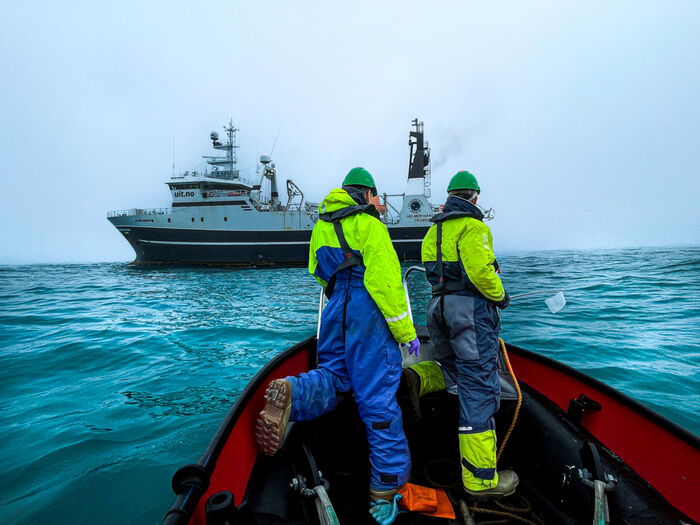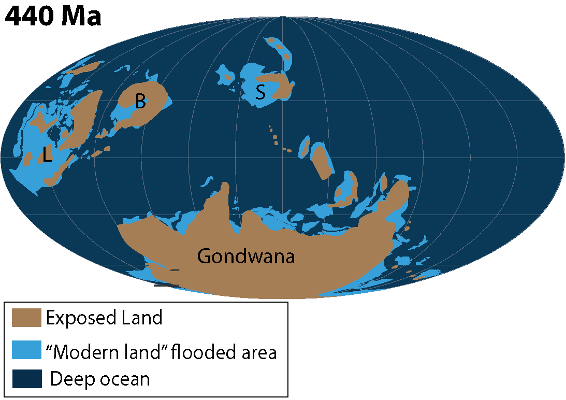Around 445 million years ago, the Earth experienced the first of its five major crises, the end-Ordovician mass extinction. This event coincided with a short but widespread glaciation that culminated a 50 million-year cooling period. Although the cooling trend is observed by several local-to-regional temperature studies, and coincides with one of the most important evolutionary diversifications on Earth, it is not yet fully understood. A new study investigated the forcings that may have triggered this intense climate change using a model that coupled climate and carbon cycle simulations.
2022
The Arctic landscape has many interesting features, many of which have names that derive from a range of languages. But who... or what... are they named after? Over the summer months, Bachelors student Annabel Flatland from Williams College in the USA joined Grace Shephard and the POLARIS project for an internship on Arctic geology and geophysics, and found out some of the origins behind a couple of the names along the way.
Ikaite is a rare mineral that is chemically identical to calcite, but has a different crystal form which contains water in its structure. It is found naturally growing in places that are characterized by low temperatures and unusual chemistry. First discovered forming tufa towers in the Ikka Fjord in Greenland (from which it gets its name), it has since been discovered growing in seafloor sediments around continents. Yet, when it is collected, it rapidly breaks down to a wet crystal mush. Little is understood about what it breaks down to and how it breaks down. So a team of researchers designed a series of experiments to observe ikaite breaking down in the laboratory, in order to find answers.
Greetings from onboard the research vessel R/V Helmer Hanssen, where we are exploring the Barents Sea, in the region south and southeast of Svalbard. It is a very international cruise, with 9 different nationalities, from six institutions, joining forces to map the polar seafloor and subsurface. In particular, we are on the hunt for bubbles (of the methane kind and not the drinking kind, sadly).
In deep time (i.e., >100 Million years ago), the number of methods that can be used to reconstruct global sea level is limited and mostly restricted to observations of changes in fossils and sediment types that mark the moving position of the shoreline. However, these methods simultaneously measure global sea-level change and local uplift or subsidence at the observation point. A new study published in Gondwana Research instead reconstructs global sea level change from estimates of past continental flooding. Flooding measurements represent averages across large continental areas, which makes them less sensitive to regional modifications. The new study demonstrates the accuracy of this method over the past 520 million years and its potential use for even deeper time.
Annique van der Boon won the 2022 formidlingskonkurranse for her article "Det usynlige skjoldet fra jordens indre"- a Norwegian language public blog article competition organized by geoforskning.no Below is the English version of the winning entry. Congratulations! Gratulerer!
NASA’s TESS mission has found two rocky worlds orbiting the relatively bright, red dwarf star HD 260655, only 33 light-years away. The new planets, HD 260655 b and HD 260655 c, are among the closest-known rocky planets yet found outside our solar system that astronomers can observe crossing the faces of their stars.
The Centre for Earth Evolution and Dynamics is pleased to announce our series "The Wilson Cycle." The four videos follow CEED researchers to western Norway where they share insights into this fundamental process that explains the formation of oceans and mountains, and more. Every two weeks during summer 2022 we released a video below and via our YouTube channel.
The Jurassic Earth was very different from today - atmospheric CO2 was higher, long-term climate was warmer, and there were no permanent polar ice-caps. The supercontinent Pangea was breaking apart, leading to changes in the configuration of the landmasses, oceans, and seaways. Using geochemical signals from fossilized marine animals, a new study in Palaeo3 looked at how the ocean currents and climates changed in the European and Arctic regions during this Greenhouse period of Earth’s history.
Around 34 million years ago the Earth underwent some major changes, including a drop in global temperatures, disturbances in ocean circulation patterns, and the formation first permanent Antarctic glaciations. But what drove this change? A new study using climate and plate tectonic modelling published in the journal PNAS suggests two additional and connected driving mechanisms from the deep Earth and the high north.
Hawaii and Iceland are two well-known "hotspot" locations, with hot, upwelling mantle plumes lying beneath them today. However, plates and plumes move relative to each other, leaving a volcanic trail in their wake. Under oceans, these "hotspot tracks" are relatively easy to identify but under thick continents it is much more difficult. A new study (Heyn and Conrad, 2022) shows how plume tracks can be identified beneath cratons and continents based on seismic observations and heat flux measurements.
The 1971 Apollo 14 mission to the Moon landed on rocks of the Imbrium Basin, the largest impact basin on the Moon – or did it? For 50 years, this statement was considered to be true, but a new study in The Planetary Science Journal describes a thin veneer of rocks from a different basin and challenges this long-held interpretation.
A new study in Nature Communications explains why spreading ridges jump towards the trench in the upper plate of narrow subduction zones. Nicholas Schliffke (Durham Uni.) and co-authors, including CEED researcher Valentina Magni, developed 3D numerical models designed to investigate the forces responsible for breaking up the lithosphere in the upper plate. They found that the occurrence of ridge jumps is controlled by a competition between the strength of the upper plate and the strength of transform faults bounding the plate.
Short-lived volcanic pulses from 201 million years-old rocks hint at anthropogenic-scale CO2 degassing events. New models reveal the impact of exceptional magmatic activity on the end-Triassic climate and environment, leading to a devastating mass extinction event. The international collaborative study published in Global and Planetary Change was led by CEED postdoc Manfredo Capriolo.

The CEED blog covers some behind-the-scenes about our latest research and activities. The contributors are a mix of students and staff from The Centre for Earth Evolution and Dynamics, Dept. of Geosciences, University of Oslo, Norway.














